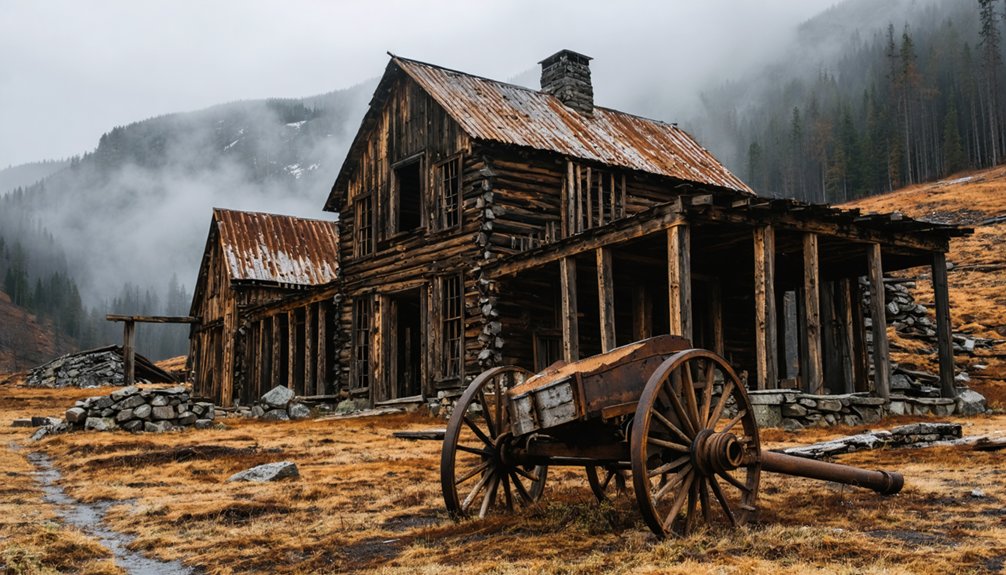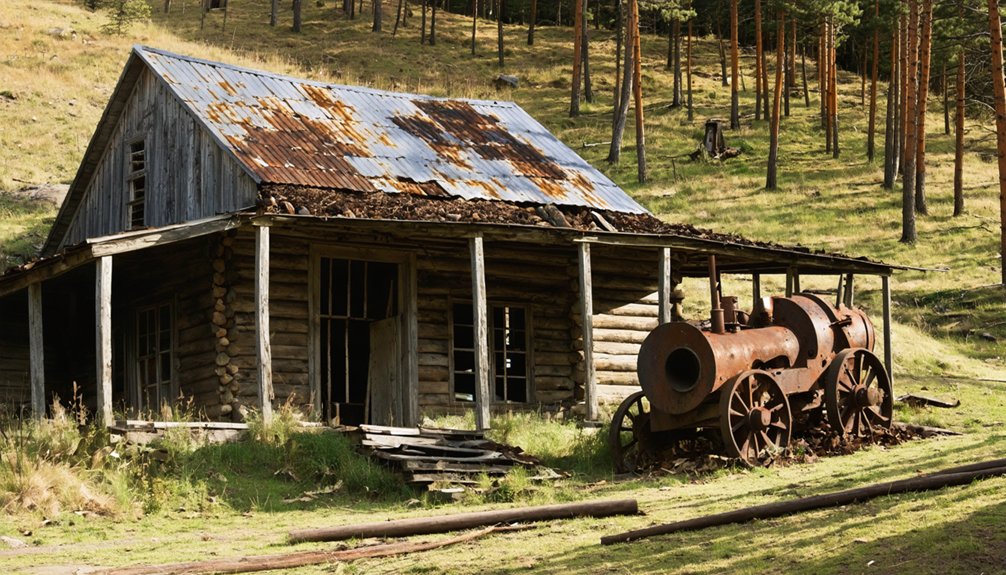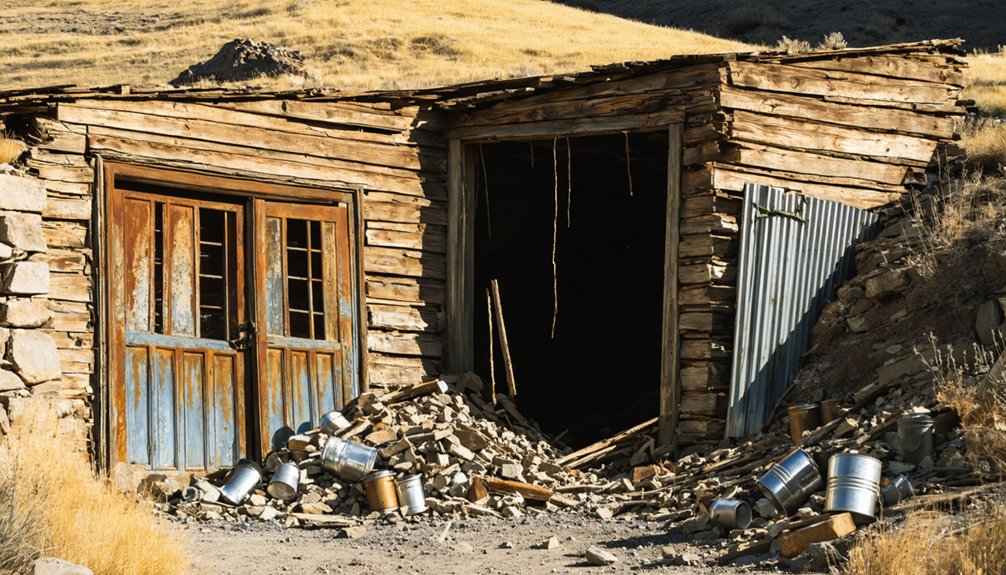You’ll find Quartzburg’s ruins in Idaho’s Boise Basin, where gold’s discovery in 1862 sparked a mining boom that lasted until 1938. The Gold Hill Mine became the town’s centerpiece, producing 450,000 ounces of gold and supporting a vibrant community with hotels, saloons, and essential services. Three devastating fires between 1929 and 1938 ultimately destroyed most structures, leaving only the adobe post office and schoolhouse standing – silent sentinels to a remarkable mining legacy.
Key Takeaways
- Quartzburg was a thriving gold mining town established in 1862 after gold’s discovery in Idaho’s Boise Basin.
- The Gold Hill Mine, Quartzburg’s economic backbone, produced 450,000 ounces of gold before closing in 1938.
- Three devastating fires between 1929-1938 destroyed most of the town’s buildings, leading to its abandonment.
- Only two original structures remain today: the adobe post office/store and the schoolhouse.
- The town’s final demise came in 1940 when the post office closed, officially transforming Quartzburg into a ghost town.
The Gold Discovery That Started It All
While many gold rushes swept through Idaho Territory in the 1860s, the discovery of gold in Boise Basin on August 2, 1862, sparked one of the region’s most significant mining developments at Quartzburg.
You’ll find the origins of this mining legacy in prospectors who traced placer gold upstream to rich quartz veins, establishing what would become the Quartzburg mining district.
The initial quartz discovery revealed free-milling gold ore within 20 feet of the surface, leading to the creation of the Gold Hill Mine by the mid-1860s.
The site’s potential quickly attracted investment, with ten quartz mills operating by 1867. To prevent confusion with other mining locations named Quartzburg, this site is often referred to as Quartzburg, Idaho.
The mine was able to process thirty-five to forty tons of ore each day after a drainage shaft was constructed.
Over its lifetime until 1938, the Gold Hill Mine yielded an impressive 450,000 ounces of gold, cementing Quartzburg’s place in Idaho’s mining history.
From Mining Camp to Bustling Town
You’ll find Quartzburg’s transformation from a simple mining camp into a vibrant town began shortly after its 1867 founding, when the Gold Hill Mine spurred rapid development.
The mine’s success attracted workers and businesses, leading to the establishment of essential services like hotels and saloons to accommodate the growing population.
By 1874, the town had grown enough to warrant the opening of a post office to serve the community.
Gold Rush Begins Here
When gold was discovered in the Boise Basin region on August 2, 1862, it sparked a transformative rush that would establish Quartzburg as a significant mining settlement.
Early prospector stories tell of determined miners following dividing streams to locate mother lodes, leading them to a promising quartz vein outcropping rich with gold.
You’ll find that Quartzburg’s mining techniques differed from other settlements, focusing on lode mining rather than placer mining.
The area attracted a diverse mix of American settlers and Chinese laborers who worked the claims extensively.
The discovery of the Gold Hill Mine in 1863-1864 proved pivotal, becoming the town’s economic backbone. The area would produce over 2.8 million ounces of gold between 1863 and 1959.
Within just a few years, you’d have seen at least 10 quartz mills operating in the Boise Basin, with Gold Hill’s 25-stamp mill processing an impressive 50 tons daily.
Hotels and Saloons Emerge
As Quartzburg’s population swelled from the Gold Hill mine’s success, the once-sparse mining camp transformed into a bustling frontier town with multiple hotels and boarding houses by 1890.
Hotel accommodations ranged from short-term lodging for transient miners to longer-stay boarding houses, supporting the town’s evolving social structure.
The vibrant saloon culture defined Quartzburg’s social fabric, with these establishments serving as hubs for business deals and information exchange.
You’d find miners gathering at saloons after long shifts, while the town’s dance hall offered structured entertainment and community bonding.
Beyond nightlife, the town established essential infrastructure including stores and a school – the latter surviving until the devastating 1931 fire.
The Gold Hill mine, discovered in 1863, operated continuously for 75 years until closing in 1938, helping sustain the town’s growth through decades of mineral production.
These amenities marked Quartzburg’s progression from a temporary camp to an established frontier community. The town’s founders David E. Coughanour and Hawley carefully planned the layout to accommodate its growing population.
Life in Early Quartzburg
In the harsh terrain of Boise County, life in early Quartzburg centered around the intensive pursuit of gold mining after its establishment in 1867.
You’d find a diverse workforce of Chinese laborers, African-Americans, and settlers from various backgrounds working the claims, where miners could extract valuable ore from depths of about 20 feet.
Community resilience emerged through the development of essential services. You’d rely on the post office for communication, frequent supply deliveries via pack trains for provisions, and the town’s general stores for basic needs.
While facing challenges like seasonal snowfalls, bandit threats, and conflicts with Native Americans, residents adapted to the remote mountain setting. Like the gold rush miners of nearby Idaho City, the population surged as thousands flocked to the region in search of riches.
The logging industry provided vital building materials and heating resources, while various professions from grocers to bartenders helped sustain daily life. The town benefited from a steam sawmill operation that could produce up to 15,000 feet of lumber in ten hours.
The Gold Hill Mine’s Golden Years
During its peak years from 1864 to 1938, you’d find the Gold Hill Mine crushing an impressive 50 tons of ore per day through its 25-stamp mill, ultimately producing over 450,000 ounces of gold.
You could witness the mine’s technological prowess through its 100-ton electrically driven fine-grinding amalgamation mill, which operated around the clock as the finest facility in the territory.
The mine’s economic impact was substantial, generating over $8 million in production value while maintaining efficient operations at $4.32 per ton of ore treated.
Peak Production Era
The Gold Hill Mine‘s most productive period began shortly after David E. Coughanour purchased it in 1867.
You’ll find that gold production reached impressive heights during this era, with the operation implementing both placer and lode mining techniques to maximize output. The mine’s sophisticated 25-stamp mill crushed 50 tons of ore daily by 1884, establishing itself as the Idaho Territory’s finest milling operation.
During the early 1910s, you’d have witnessed annual production exceeding $500,000, showcasing the mine’s sustained success.
The operation expanded to include a 1,246-foot vertical shaft with nine intermediate levels, creating over 40,000 feet of workings. By the time it closed in 1938, the mine had yielded more than 450,000 ounces of gold, valued at $8 million.
Mill Technology and Innovation
Gold Hill Mine’s exceptional production levels stemmed directly from its advanced milling operations, anchored by a sophisticated 25-stamp mill that operated around the clock.
You’ll find this facility was regarded as Idaho Territory’s finest, processing an impressive 50 tons of ore daily by the mid-1880s.
The mine’s milling techniques evolved considerably over time, incorporating both traditional and cutting-edge technologies.
A major technological advancement came with the introduction of a 100-ton electrically driven fine-grinding amalgamation mill, which revolutionized the operation’s efficiency.
The mill’s integration with over 40,000 feet of underground workings and a 1,246-foot vertical shaft, featuring nine intermediate levels, guaranteed seamless ore delivery.
This sophisticated system supported continuous extraction until a devastating fire in 1931 destroyed the original mill buildings.
Economic Impact and Employment
As mining operations flourished between 1863 and 1938, the Gold Hill Mine generated an impressive 450,000 ounces of gold valued at over $8 million, establishing itself as a cornerstone of Idaho Territory’s economy.
You’ll find the mine’s economic sustainability was built on diverse operations, including both placer and lode gold extraction, with additional revenue from silver, lead, and zinc production.
The labor demographics reflected the era’s mining culture, with a workforce large enough to operate 25 stamp mills processing fifty tons of ore daily.
Chinese laborers contributed notably to the region’s mining workforce. The mine’s presence created a complete economic ecosystem in Quartzburg, employing miners, mill workers, and support staff.
When the mine closed in 1938, it triggered Quartzburg’s transformation from a thriving boomtown to a ghost town.
Notable Residents and Community Life
While many Western mining towns struggled to maintain stable populations, Quartzburg sustained a remarkably consistent community, with residents numbering between 91 and 152 from 1870 through 1920.
The town’s community dynamics reflected both social stratification and cultural diversity, with Chinese laborers playing a crucial role in mining operations while maintaining their distinct cultural heritage.
You’ll find that notable residents shaped the town’s character, including James Hawley, who married in Quartzburg before becoming Boise’s mayor and Idaho’s governor.
The social fabric centered around dance halls, saloons, and a variety of businesses that served the mining community. The townsfolk often gathered for shared winter activities, including dances and dinners that helped build strong community bonds.
Despite the challenges of frontier life, Quartzburg offered its residents essential services including a post office, school, and multiple lodging options, fostering a close-knit community that persisted for decades.
Devastating Fires and Natural Disasters

The close-knit community of Quartzburg faced devastating natural disasters that would ultimately seal its fate. Despite early fire prevention efforts, including fireproof paint on the schoolhouse and strategic open spaces, the town suffered three major blazes between 1929 and 1938.
While community resilience showed after the 1929 fire with a slight population increase, the 1931 inferno proved more destructive, consuming every building except the adobe post office and protected schoolhouse. Ed Foster helped feed displaced families in the aftermath.
The final blow came in 1938 when flames destroyed the remaining mining infrastructure, leading to the post office’s closure in 1940. The combination of these fires, coupled with the 1941 Mining Act’s restrictions during WWII, transformed this once-thriving mining town into a permanent ghost town.
The Final Days of Mining Operations
Mining operations at Quartzburg’s Gold Hill Mine, which had flourished since the 1860s with a remarkable output of 450,000 ounces of gold, faced mounting challenges during the 1930s that would ultimately end its productive life.
After decades of prosperity and nearly half a million ounces of gold, Quartzburg’s legendary mine succumbed to 1930s hardships.
You can trace the mining decline through several key events that sealed the fate of this once-thriving operation:
- The devastating 1938 mill fire crippled ore processing capabilities, dealing a severe blow to the mine’s final operations.
- The Great Depression’s economic strain reduced mining profitability and investment opportunities.
- The 1941 Mining Act’s wartime restrictions on precious metal mining delivered the final blow, effectively ending small-scale operations.
Rising costs, declining ore grades, and the dismantling of essential infrastructure transformed this bustling mining town into a ghost town by 1940, marked by the closure of its post office.
What Remains Today

Today at Quartzburg, you’ll find a remarkably sparse landscape where only two original structures – the post office/store and schoolhouse – remain standing as evidence to this once-thriving mining settlement.
The schoolhouse, built from adobe or low-fired brick, survived the devastating 1931 fire that destroyed most other buildings due to its fireproof construction.
Archaeological findings reveal the site’s rich mining heritage through over 180,000 tons of ore tailings, remnants of the Gold Hill Mine that yielded 450,000 ounces of gold.
While foundations and mining equipment lie scattered across the 289-acre private property, environmental preservation efforts continue as modern mining operations process historic tailings.
Access is restricted by gates, though you can still view the ghost town’s forested mountain setting from nearby Granite Creek Road at 4,675 feet elevation.
Historical Significance in Idaho Mining
While physical remnants of Quartzburg may be sparse, its impact on Idaho’s mining legacy runs deep. The district’s mining techniques evolved from simple placer operations to sophisticated lode mining, with the Gold Hill Mine‘s 25-stamp mill processing an impressive 50 tons of ore daily. This mining powerhouse contributed more gold during the Civil War era than both the California and Klondike rushes.
The district’s cultural diversity shaped Idaho’s frontier development through:
- A substantial Chinese workforce that comprised nearly half of Idaho City’s population by 1870
- The convergence of Eastern U.S. miners with global immigrants, fostering multicultural communities
- A progressive environment that helped Idaho become the fourth state to grant women’s suffrage in 1896
You’ll find Quartzburg’s influence embedded in Idaho’s social and economic foundations, from its technological innovations to its diverse cultural heritage.
Frequently Asked Questions
Is Quartzburg Accessible by Car Today?
You’ll need a 4WD vehicle for limited access to Quartzburg’s ghost town site via rough forest service roads, though you can’t drive directly to most historical remains.
Are There Any Dangerous Mine Shafts to Avoid in the Area?
You’ll need to avoid the 1,246-foot Gold Hill Mine shaft and over 40,000 feet of unstable tunnels. For mine safety, don’t explore underground workings – many dangerous shafts remain unmarked and hidden.
Do You Need Permits to Explore the Quartzburg Site?
Yes, you’ll need explicit landowner permission since it’s private property. No general public permits exist for exploration. If you venture onto nearby public lands, you’ll need Forest Service permits for any mining activities.
What Happened to the Gold Mining Equipment After the Town’s Abandonment?
Like scattered breadcrumbs in time, the gold mining equipment met three fates: you’ll find some was sold for scrap, some burned in the 1931 fire, and remaining equipment remnants simply rusted away.
Were Any Significant Artifacts Recovered From the Quartzburg Site?
You won’t find any documented significant artifacts specifically from Quartzburg, though the broader Boise Basin mining history has yielded various mining-era items from neighboring settlements in the region.
References
- https://en.wikipedia.org/wiki/Quartzburg
- https://yellowpinetimes.wordpress.com/2024/03/10/idaho-history-mar-10-2024/
- https://westernmininghistory.com/towns/idaho/quartzburg/
- https://www.youtube.com/watch?v=1hF2mr–zTs
- https://motoidaho.com/articles/gold-mining-ghost-towns-near-boise/
- https://history.idaho.gov/wp-content/uploads/2018/08/0064.pdf
- https://www.ghosttowns.com/states/id/quartzburg.html
- http://www.ghosttowngallery.com/htme/idahocity.htm
- https://pubs.usgs.gov/bul/0640e/report.pdf
- https://history.idaho.gov/wp-content/uploads/2018/08/0009.pdf



